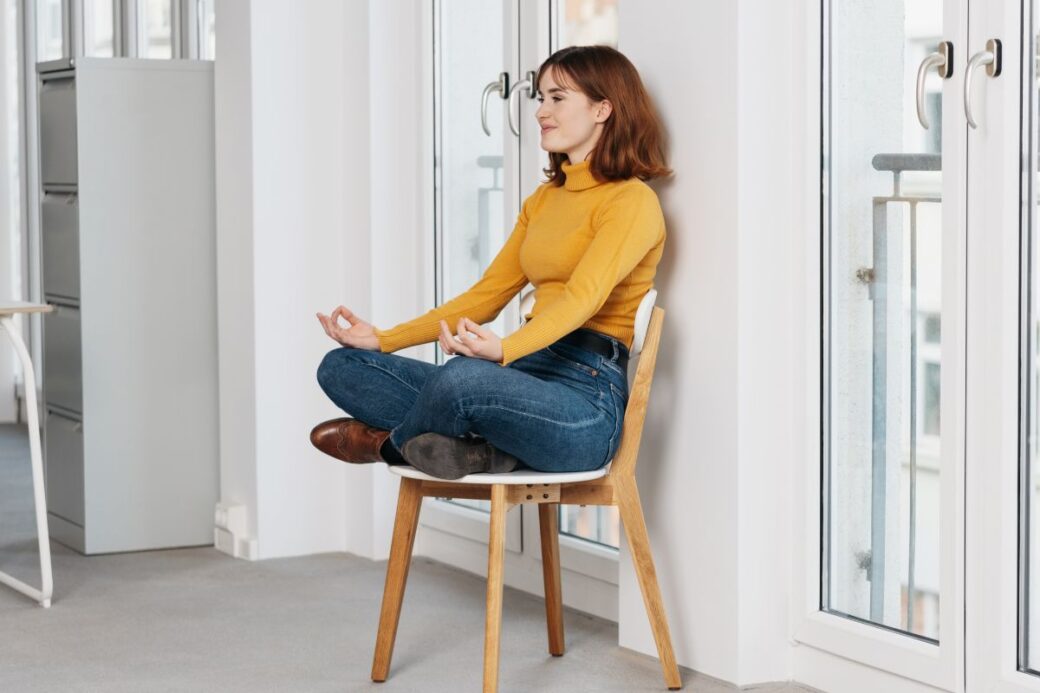Unleash your inner zen while comfortably seated – that’s the question we’re exploring in this article: can you meditate in a chair? While we often associate meditation with sitting crossed-legged on the floor, this ancient practice doesn’t have to be limited to a cushion. Discover the potential of meditating in a chair, as we uncover the benefits, techniques, and tips to enhance your mindfulness practice right from the comfort of your seat.

Can You Meditate In A Chair: Understanding Meditation
What is Meditation?
Meditation is a practice that has been around for centuries and is known for its ability to promote relaxation, reduce stress, and enhance overall well-being. It involves focusing your attention and eliminating the stream of thoughts that may be running through your mind. By doing so, meditation allows you to achieve a state of deep relaxation and tranquility. It is often described as a way to calm the mind and connect with your inner self.
The Purpose of Meditation
The purpose of meditation varies from person to person, but its core objective remains the same: to achieve a heightened state of awareness, inner peace, and overall well-being. Some people meditate to reduce stress and anxiety, while others use it as a tool for self-discovery and personal growth. Meditation can also help improve concentration, enhance creativity, and promote emotional stability. Ultimately, it is a practice that can lead to a greater sense of self-awareness and a more balanced and fulfilling life.
Different Forms of Meditation
There are various forms of meditation, each with its own unique techniques and practices. Some popular forms include mindfulness meditation, transcendental meditation, loving-kindness meditation, and guided visualization. Each form has its own benefits and can be tailored to fit individual preferences and goals. It’s important to explore different forms of meditation to find the one that resonates most with you and aligns with your meditation goals.
Importance of Location in Meditation
Choosing the right location for meditation is essential in creating an environment conducive to relaxation and focus. Ideally, you want a quiet and peaceful space where you won’t be easily disturbed. This could be a dedicated meditation room, a corner of your bedroom, or even a secluded outdoor spot. The location should be free from distractions and clutter, allowing you to fully immerse yourself in the practice. Creating a serene environment can greatly enhance the effectiveness of your meditation sessions.
Challenges in Traditional Meditation
Physical Discomfort and Limitations
One of the challenges people often encounter in traditional meditation is physical discomfort. Sitting on the floor for an extended period can lead to numbness, aches, and stiffness, making it difficult to focus on the practice. This discomfort can be especially pronounced for individuals with physical limitations or certain health conditions. Finding a comfortable position that allows for proper alignment can be a hindrance for many, discouraging them from practicing meditation regularly.
Space Constraints
Another challenge in traditional meditation is the issue of space constraints. Not everyone has access to a dedicated meditation room or a spacious area at home solely for this purpose. Limited space can make it challenging to find a quiet and private location to meditate, leading to distractions and interruptions. This can hinder the ability to fully relax and concentrate during meditation sessions, making it harder to reap the desired benefits.
Finding Ideal Meditation Spaces
Even if you do have access to a peaceful location, it may not always be available or convenient for regular meditation practice. For instance, if you travel frequently or have a busy lifestyle, finding a suitable meditation space outside of your usual environment can be a challenge. This can disrupt your routine and make it harder to maintain a consistent meditation practice. The need for a more versatile and convenient solution led to the emergence of chair meditation.

The Concept of Chair Meditation
Definition of Chair Meditation
Chair meditation, as the name suggests, refers to practicing meditation while sitting in a chair instead of on the floor. It is a modification of traditional meditation that provides a more accessible and comfortable option for individuals who struggle with the physical demands of sitting on the ground. By using a chair, you can maintain proper posture and alignment, reducing the risk of discomfort and enabling a more focused meditation experience.
The Need for Chair Meditation
Chair meditation addresses the challenges faced by those who find it difficult to maintain a seated position on the floor. It eliminates physical discomfort and limitations, making meditation more accessible to a wider range of individuals. Chair meditation allows people with injuries, chronic pain, or mobility issues to comfortably engage in meditation without straining their bodies. It also provides an alternative for those who struggle to find an ideal meditation space or need a portable option for meditation on the go.
Benefits of Chair Meditation
Chair meditation offers a range of benefits that make it a valuable practice for individuals seeking a more versatile meditation experience. Some of the key benefits include:
- Comfort: Sitting in a chair allows for better support and reduces the risk of discomfort or pain commonly experienced when meditating on the floor. This enables individuals to focus their attention on the meditation practice itself.
- Accessibility: Chair meditation is accessible to a wider range of individuals, including those with physical limitations or health conditions. It is a more inclusive practice that allows everyone to experience the benefits of meditation.
- Convenience: Chairs are readily available in most environments, making chair meditation a convenient option. It eliminates the need to find a dedicated meditation space, enabling you to practice meditation in various settings such as home, office, or even during travel.
Pre-requisites of Chair Meditation
Types of Suitable Chairs
When practicing chair meditation, it is important to choose a chair that provides proper support and aligns with your body’s needs. A suitable chair for meditation should have a straight backrest that allows for an upright posture. Avoid chairs with excessive cushioning or reclining features, as they can hinder proper alignment and make it more difficult to maintain focus. A sturdy and comfortable chair, such as an upright dining chair or an ergonomic office chair, can be ideal for chair meditation.
Ideal Environment for Chair Meditation
Creating a suitable environment for chair meditation is essential to maximize its benefits. Find a quiet and peaceful location where you can sit without distractions. Ensure that the space is well-ventilated and at a comfortable temperature. You may choose to dim the lights or light candles to create a serene ambiance. Personalize the space with calming elements such as plants, cushions, or artwork that resonate with you. This dedicated meditation space will enhance your overall experience and help you get into the right mindset for meditation.
Required Mental State
Just like in traditional meditation, cultivating the right mental state is crucial in chair meditation. Set an intention for your practice and clear your mind of any distractions or thoughts that may arise. Approach chair meditation with an open and non-judgmental attitude, allowing yourself to fully immerse in the present moment. Let go of expectations and focus on the sensations and feelings that arise during your meditation. Embrace a sense of curiosity and acceptance, and be patient with yourself as you develop your chair meditation practice.
Procedure for Chair Meditation
Upright Posture and Alignment
Maintaining an upright posture is essential in chair meditation for optimal breathing and focus. Sit towards the edge of the chair with your feet flat on the ground, adjusting the height if needed. Keep your back straight, shoulders relaxed, and chin slightly tucked in. Align your head, neck, and spine, as this allows for proper energy flow and reduces the risk of discomfort. It can be helpful to imagine a string pulling the crown of your head towards the ceiling, elongating your spine and creating a sense of lift.
Breathing and Relaxation Techniques
Once you have settled into a comfortable upright posture, focus your attention on your breath. Take slow and deep breaths, inhaling through your nose and exhaling through your mouth. Allow your breath to flow naturally and rhythmically, without forcing or controlling it. Notice the sensation of the breath as it enters and leaves your body, letting go of any tension or stress with each exhalation. This rhythmic breathing will help calm your mind and relax your body, preparing you for a deeper meditation experience.
Focal Points and Attention
In chair meditation, you can choose a focal point to anchor your attention. It can be your breath, a specific sensation in your body, or a mantra or phrase that you repeat silently to yourself. Direct your attention to the chosen focal point, gently guiding your mind back whenever it wanders. It is natural for thoughts to arise during meditation, but the key is to observe them without judgment and gently bring your focus back to the present moment. Cultivate a sense of curiosity and openness as you explore your own inner landscape.
Common Mistakes in Chair Meditation
Wrong Posture
One common mistake in chair meditation is adopting a slouched or relaxed posture. This can lead to decreased focus, discomfort, and a lack of alignment. To avoid this, make sure to sit towards the edge of the chair, keeping your back straight and shoulders relaxed. Maintaining an upright posture allows for better breath control and energy flow, enhancing the overall effectiveness of your meditation practice.
Ignoring Distractions
Distractions are bound to arise during meditation, especially when practicing in a non-isolated environment. Ignoring these distractions or becoming frustrated by them can hinder your progress. Instead, acknowledge the distractions without judgment and gently redirect your attention back to your chosen focal point. Remember that meditation is a continuous practice, and each moment is an opportunity to cultivate mindfulness and resilience.
Rushing the Process
Perhaps one of the most common mistakes is rushing through the meditation process. Trying to achieve a certain state of mind or immediate results can create unnecessary pressure and expectations. Remember that meditation is a journey, not a destination. Give yourself permission to simply be present and observe without striving for a specific outcome. Embrace the process and allow yourself to fully experience each meditation session, regardless of how calm or busy your mind may feel.
Steps to Perfect Chair Meditation
Incrementing Sitting Periods
To perfect your chair meditation practice, it is beneficial to gradually increase the duration of your sessions. Start with shorter periods, such as 5-10 minutes, and gradually work your way up to 20-30 minutes or longer, depending on your comfort level. This gradual progression allows your mind and body to adapt to the practice and nurtures a sense of consistency and discipline. The more you practice, the easier it becomes to enter a deep state of meditation and fully enjoy its benefits.
Balancing Mental and Physical Relaxation
While relaxation is a key component of meditation, it’s important to strike a balance between mental and physical relaxation. Sometimes, individuals may become too relaxed to the point of drowsiness or lack of focus. To counter this, maintain an alert but relaxed state throughout your chair meditation. Check-in with your body regularly, ensuring that you are comfortable and not experiencing any unnecessary tension. This balance promotes a state of calm alertness, allowing for a more fulfilling meditation experience.
Creating a Routine
Consistency is key when it comes to meditation. Creating a regular routine will help integrate chair meditation into your daily life. Set aside a specific time each day for meditation, whether it’s in the morning, during lunch breaks, or before bed. By establishing a routine, you make meditation a priority and are more likely to commit to regular practice. Consistency allows you to fully experience the cumulative benefits of meditation and make it an integral part of your overall well-being.
Benefits of Chair Meditation
Physical Benefits
Chair meditation offers several physical benefits that contribute to overall well-being. By practicing in a comfortable seated position, you reduce the risk of discomfort and physical strain. This can be particularly beneficial for individuals with chronic pain, injuries, or mobility issues. Chair meditation also promotes better posture and alignment, which can alleviate back, neck, and shoulder tension. Additionally, the deep relaxation achieved through meditation can help lower blood pressure, enhance immune function, and improve sleep quality.
Mental Benefits
Chair meditation is known for its positive impact on mental health and emotional well-being. Regular practice can help reduce stress and anxiety, promote emotional stability, and increase resilience to challenges. It cultivates a sense of mindfulness and presence, allowing individuals to better manage their thoughts and emotions. Chair meditation can also enhance focus, concentration, and memory, making it a valuable tool for improving cognitive function and overall mental clarity.
Increased Versatility in Meditation
One of the greatest benefits of chair meditation is its versatility. Unlike traditional meditation that often requires a specific sitting posture on the floor, chair meditation can be practiced virtually anywhere. Whether you’re at home, in the office, or traveling, a chair is typically accessible, providing you with the opportunity to meditate conveniently. This increased versatility allows for a more consistent meditation practice and empowers individuals to incorporate mindfulness into their daily lives with greater ease.
Incorporating Chair Meditation into Daily Life
Meditating at Work
The workplace can be a stressful environment that demands our attention and energy. Chair meditation offers a simple yet effective way to find calm and focus amidst a busy workday. Set aside a few minutes during your lunch break or find a quiet corner in your office where you can sit comfortably in a chair. Close your eyes, center your attention, and allow yourself to enter a meditative state. The practice of chair meditation at work can boost productivity, reduce stress, and improve overall well-being.
Meditating at Home
Whether you have a dedicated meditation space or a cozy corner in your living room, practicing chair meditation at home is a wonderful way to unwind and reconnect with yourself. Create a tranquil and inviting atmosphere by adding soft lighting, calming scents, or playing relaxing music. Set aside a specific time each day for your meditation practice and commit to it. The familiarity of your home environment combined with chair meditation can help deepen your practice and facilitate a greater sense of inner peace.
Short Meditation Breaks
Incorporating short meditation breaks throughout the day can be a powerful way to recharge and reset. These breaks can range from a few minutes to as long as your schedule permits. Find a quiet chair, even if it’s in the midst of a bustling environment, and dedicate those moments solely to yourself. Use this time to breathe, relax, and bring your attention to the present moment. Short meditation breaks can help alleviate stress, increase focus, and provide a much-needed mental and emotional reset during busy and demanding days.
Frequently Asked Questions about Chair Meditation
Who can Benefit from Chair Meditation?
Chair meditation is suitable for anyone seeking the benefits of meditation but struggles with the physical demands of traditional sitting positions. It is particularly beneficial for individuals with physical limitations, chronic pain, injuries, or mobility issues. Chair meditation offers a comfortable and accessible alternative, allowing everyone to experience the positive effects of meditation.
Is Chair Meditation as Effective as Traditional Meditation?
Yes, chair meditation can be just as effective as traditional meditation when practiced with intention and focus. The key lies in the ability to cultivate a calm and focused state of mind, regardless of the sitting position. By creating a dedicated space, maintaining proper posture, and using guiding techniques, chair meditation can provide similar benefits to traditional forms of meditation.
How Long should a Chair Meditation Session Last?
The duration of chair meditation sessions can vary depending on individual preferences and comfort levels. It is recommended to start with shorter sessions, such as 5-10 minutes, and gradually increase the duration as you become more comfortable and experienced. With regular practice, you can aim for 20-30 minutes or longer, if desired. Remember that consistency is more important than duration, so it is better to have a shorter daily practice than a longer one sporadically.
In conclusion, chair meditation offers a versatile and accessible approach to the practice of meditation. With its focus on comfort, practicality, and adaptability, chair meditation allows individuals of all backgrounds and physical abilities to experience the numerous benefits of meditation. By incorporating chair meditation into your daily life, whether it’s at work, home, or during short breaks, you can unlock the versatility of meditation and cultivate a greater sense of well-being, balance, and inner peace.




